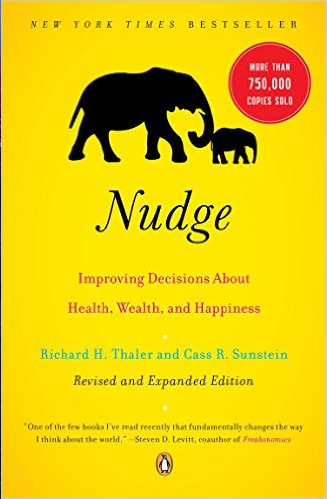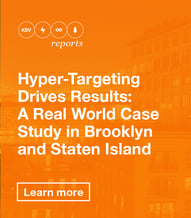Last week at the BECC Conference in Baltimore, KSV had the great honor and privilege of being asked to speak on three different topics.

If you want to talk about millennials, marketing, or the voice of the customer, reach out and we'd be happy to share our decks with you.
But of all the talks we saw, the opening keynote held so many takeaways and thought provoking moments, we just had to share three key opportunities that you can begin implementing into your marketing TODAY.
Nudging for Good.
Dr. Cass Sunstein, Harvard Law School Professor and the most frequently cited American legal scholar by a wide margin, presented so much good content, the takeaway here is really that if you haven't already, run, don't walk, to get Nudge: Improving Decisions about Health, Wealth, and Happiness.

Three things that Dr. Sunstein said really stuck out to us as being useful and actionable for energy, b2b, and sustainability marketers immediately.
1. The power of inertia cannot be overestimated.
Ok, we all know this, inherently. The easiest thing to do is nothing.
But how can companies utilize this piece of insight?
Default settings.
Look at Apple. When they want you to pay attention to a new app, they don't ASK if you want to download it, it is a part of the new iOs upgrade. So why does Apple have this collective permission to play with our default settings but so many companies believe that they don't?
Quality.
We trust Apple to anticipate our needs. To innovate faster than we can imagine.
So, what are the defaults your business is not taking advantage of? What processes could you put in place to make your customers have a better, faster, smarter, easier, more valuable experience?
And what, exactly, is stopping you?
2. Recognize the present bias.
This experiment was fascinating. Let's see if we can replicate it in reading format, shall we?
Ok, for five seconds, we want you to imagine yourself on vacation on your favorite beach in the world. You just got a surprise vacation, and you can take your favorite people in the world with you to the beach, with no strings attached, tomorrow.
Go there. Remember the last time you were there. What did it feel like? Sound like? Smell like? What do you hear?
Did you get there? Did you feel a momentary relaxation?
Ok. Now, do the same thing, but imagine that you are going to that same beach 18 months from now.
18 months in the future.
Could you do it? Could you imagine yourself there?
It turns out that trying to think of yourself, in the future, is neurologically like trying to imagine a stranger.
Our brains are just not hardwired to do this.
So how does this affect your marketing?
Well, let's just say you market a product with big implications on the future.
Like, oh, maybe energy?
Or... insurance.
When we go out and talk to people on the street they always bring up the future. "Future generations," they say, "I want to leave them something!"
In fact they are often so moving that we could almost be fooled into thinking a future-oriented message is one that would work.
But, what have we learned here so far?
The power of inertia cannot be overestimated.
People have a bias toward the present.
Trust me when I tell you, never in all my days did I think I would be quoting behavioral economists and law professors in a marketing blog, and yet, here we are, and it's making a lot of sense.
So if people can't even imagine themselves 18 months in the future, if that is the neurological equivalent of trying to imagine a strangers thoughts, feelings and experiences, then will that marketing message work?
Nope.
BUT. Could we imagine a family member in the future? Could we attach a future moment to a visceral experience (like, the holidays, for instance), a time when we are almost remembering the future? It's not that future oriented messages can never work, it's just that we need to remember that our consumers, no matter how rational, pragmatic, or logical they are, are hardwired to favor the present over the future.
And inaction over action.
So whatever your marketing is, it has some big hurdles to get over.
3. Reminders and simplifying devices are the preferred nudges of choice.
Ok, this may be one of the most exciting pieces. Turns out that people are open to changing their behavior if we A) Remind them and B) Make it simple.
Sounds easy, right?
But simple is never easy. Certainly not inside companies. And in order for reminders to work, we need people to pay attention to them. And that means: we have to break through the clutter and be relevant and valuable.
We have to be helpful.
But the idea of reminders, of simple nudges in everyday life is a pretty amazing concept for your marketing.
Now, there are a lot of "as a service" companies out there trying to automate this process and make it easily buy-able for companies. And some of them actually work. I'm not suggesting this is a new or novel concept.
But not many of them are using advanced hyper-targeted marketing channels to reach people in the moments that matter most, the moments leading up to a decision (well, we do know of one company that is doing this).
So the takeaways here are clear:
1. The power of inertia cannot be overestimated
2. Play to the present bias
3. Reminders and simplifying devices are the nudges of choice
Easy, right?
Maybe easier said than done.
_________________________________________________________________
Want even more insights? Read about how we used hyper-targeted marketing in Brooklyn to drive energy efficiency participation and enter into a moment that mattered for consumers.

 Download the brief now.
Download the brief now.